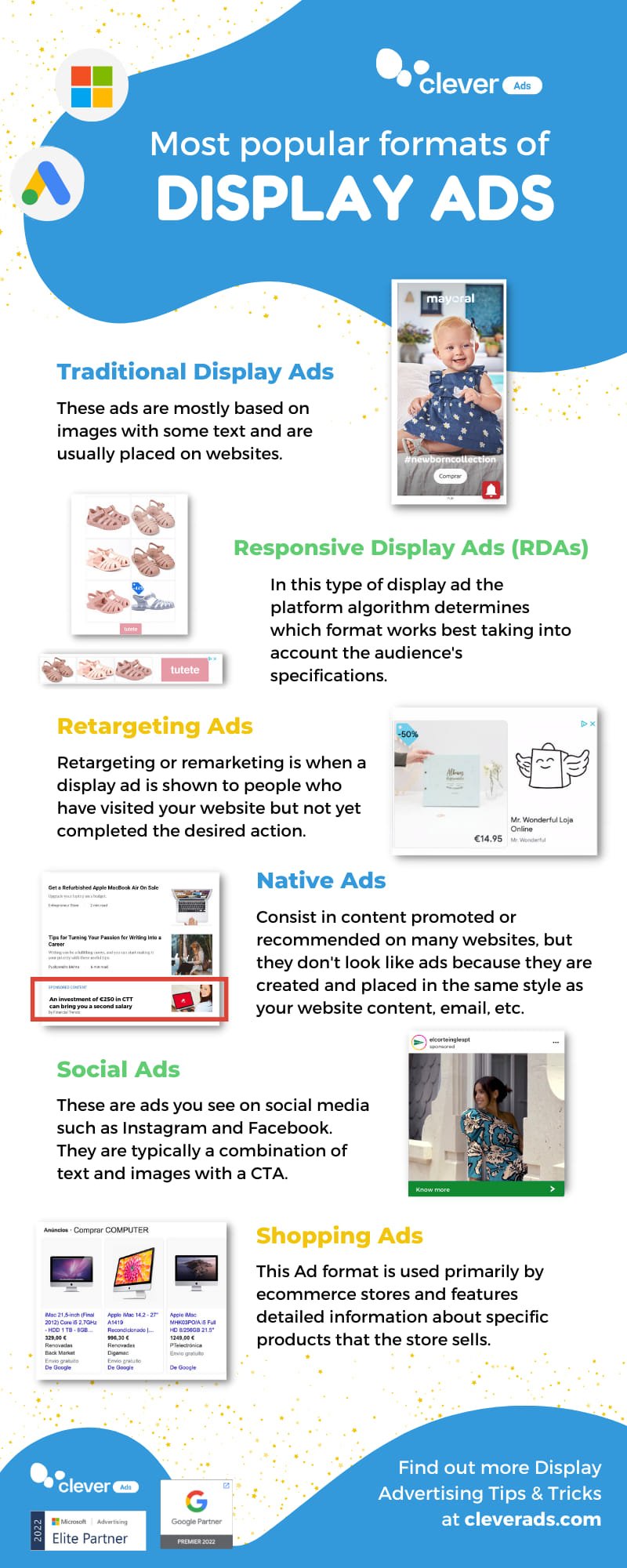Display Ads: all you need to know
Display ads are image and video ads shown to people as they browse websites, apps, and social media. They are one of the best ways to raise awareness of your business. With this kind of advertising, you can boost your business and convert more web browsers into customers.
Let’s check some basic definitions of this type of Ad:
What are Display Ads?
Display advertising uses images or videos combined with text and a link to your website in order to let consumers know more about your services or products. They can have different shapes and sizes. They can also be static with just one image or dynamic with videos, multiple images or other eye-catching elements.
This kind of Ad usually feature a product image, brand, and call-to-action (CTA).It is also used to incentivize website visitors and promote brand awareness in order to drive website visits and increase online purchases.
Most popular Display Ads formats
As mentioned before, there are several types of display ads, here is a list of the most popular ones:
Traditional Display Ads
These ads are mostly based on images with some text and are usually placed on websites.
Responsive Display Ads (RDAs)
In this type of display ad, the platform’s algorithm determines which ad combinations (created using a list of assets you provide) work best based on how the audience interacts with the ads.
Retargeting Ads
Retargeting or remarketing is when a display ad is shown to people who have visited your website but have not yet completed the desired action.
Native Ads
These ads don’t look like ads because they are created and placed in the same style as your website content, email, etc. They are designed to look like natural content.
Social Ads
These are ads you see on social media such as Instagram and Facebook. They are typically a combination of text and images with a CTA.
Shopping Ads
This ad format is used primarily by eCommerce stores and features detailed information about specific products that the store sells.

Other types of Display Ads
- Interstitial Ads are interactive, full-screen ads that cover the interface of their user. Examples: a non-skippable video ad or a full-page pop-up before the show the news article that you want to read.
- Overlay Ads are small banners shown at the bottom of a video’s screen without obstructing the user’s view. The users can interact with this type of ad and turn them off. If you click in one of these ads they willl take you to a landing page assigned by the advertiser.
- Lightbox Ads are non-intrusive, engaging, and require a user-initiated 2-second delay before expanding. This expandable format reduces accidental expansion and preserves user experience while increasing advertiser ROI.
- Rewarded Ads offers a prize to the user watching promoted display content. For example, free coins in an advertised game.
3 Reasons to run Display Advertising
Display ads can be easily tracked to measure efficiency
With display advertising, you can check how often your ads were seen and how many people clicked on your ads. Since this type of advertising is a brand awareness marketing strategy, the key metric you should consider measuring is ad impressions.
Display Ads are visually appealing
You can use graphics, video, audio, and your company branding to stand out and grab the users’ attention. Be as creative as possible and adhere to the “less is more” rule in your designs.
Display Ads allow for remarketing opportunities.
Remarketing is a great way to connect with potential customers who have visited your website and haven’t completed a conversion (conversions are actions you deem valuable to your business, such as a purchase, phone call, newsletter subscription, etc.)
Remarketing allows your business to run display ads that target users who have already visited your site. These advertisements will appear to the user as he browses another website. When a potential customer knows about your product or service, a well-placed display ad can remind them to make a purchase, through eye-catching ads.
Basic metrics to measure Display Advertising success:
When it comes to display advertising campaigns, the essential results you should be tracking are:
- Impressions: Refers to how many times your ad content was displayed to your potential customers. Keep in mind that if you’re getting a lot of impressions but few clicks, it shows that your ad copy is not compelling enough or that you need to make your ad more appealing.
- Clicks: Counts how many of those impressions result in clicks on your ad, which leads you to the advertiser’s landing page. If you have a lot of clicks but you’re getting few conversions, it’s a sign that you should update your landing page.
- You should also check the time users spend on your site and conversions to see if people are engaging with your landing page content and becoming your customers.
Now that you know more about the display campaigns, it’s time to get down to work and start improving your brand awareness today. Try to experiment with different types of display ads in your next Google Ads campaign.
Are you thinking of creating some new banners to try out display ads and don’t know where to start?
Try our Banner Creator for Google Ads.
At Clever Ads we have the best online advertising tools for your business. Take a look and boost your online advertising performance.
Still have doubts? Contact us, we’ll be happy to help! 🙂





Interesting read! I just knew now in detail the different types and formats of display ads on websites. Do display ads also need website wireframes?